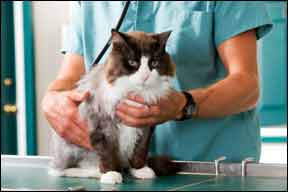Perhaps the most important characteristic of a responsible cat owner is the ability to distinguish the signs of minor feline illnesses from those calling for an immediate trip to the nearest animal emergency 288 care facility. Cat owners should be equipped ahead of time to deal promptly with such a crisis. They should know precisely where the clinic is located, the speediest route to get there, how to transport the afflicted animal, what documents they should take to the facility – and what to expect to happen upon arrival. Feline emergency cases are by no means rare, says Gretchen Schoeffler, DVM, chief of emergency and critical care services at the Cornell University Hospital for Animals (CUHA). She and her colleagues typically treat as many as 10 or 15 severely ill cats each week in the hospitals emergency unit, which, like most such facilities in the U.S., is open 24 hours a day, seven days a week. Frequent Crises. The emergency staff at CUHA, she notes, comprises a blend of board-certified experts in emergency care, interns, residents and support personnel, all of whom are associated with Cornells College of Veterinary Medicine. Among the many feline conditions requiring emergency treatment, Dr. Schoeffler identifies the following as both relatively common and especially life-threatening: Being Prepared. These, says Dr. Schoeffler, are “absolutely life-threatening emergencies” that must be addressed without delay. The immediate task is to transport the cat carefully to an emergency care facility without delay. She recommends the following: Know where youre going. Keep the phone number of the nearest veterinary emergency clinic handy, and phone ahead to tell the staff that you are on your way and when you are likely to arrive. Transport the animal in a carrier. “Being loose in a car can be very stressful for a sick or injured cat,” she notes, “and you never know how it will behave if it becomes panicked while youre driving. And that, of course, can be very dangerous. Likewise, when you arrive at the clinic, there will be strange sounds and smells and maybe dogs or other animals in the receiving area. Especially for a cat that is having breathing problems, the stress might be enough to put it over the edge.” Take relevant documents. Always keep your cats medical records and vaccination certificates handy and be sure to take them with you when you go to the emergency care facility. Says Dr. Schoeffler: “We would need to know, for example, if your cat is diabetic or has some other chronic health problem. And we would want to know whether the cat is current on its rabies shots in case one of the staff is scratched or bitten while the animal is being cared for.” You should also take your routine veterinarians phone number along in case he or she needs to be contacted by the emergency staff. Be prepared to wait. “We basically operate on a first-come first-served basis,” she notes, “but animals that are severely unstable when they arrive must take priority over more stable animals. So there may be a wait involved, and we ask people to be patient with us and to understand our priorities.” You can expect to be charged an emergency fee whether your cat is admitted as an inpatient or sent home as an outpatient. The fee will cover a review of the animals medical history and a physical examination. Estimates for additional diagnostic tests of medical treatment will usually be given at the time of the emergency room visit. Payment will be expected at the time service is rendered.
Emergency Care for Your Cat
Dont wait until illness strikes. Have a plan in place in case your cat ever needs immediate veterinary help.
Respiratory distress, a condition in which a cats ability to breathe is seriously impaired as the result of disease or injury. Signs include a dramatic increase in an affected cats intake and exhalation of air, a bluish color in its normally pink gums and noticeably cool skin. Without prompt care, an animal in such a state of respiratory distress is likely to succumb due to oxygen deprivation. The three most common causes of respiratory distress in cats are heart failure, asthma and (in outdoor cats) trauma.
Urethral obstruction, a mass of protein, cellular debris, and crystallized mineral that blocks the urethra. An affected animal must receive immediate treatment; in some cases, a delay of only a few hours can be fatal. This condition is very common in male cats and very rare in females.
Traumatic wounds and fractures, especially those involving a cats spine, chest or abdomen.



